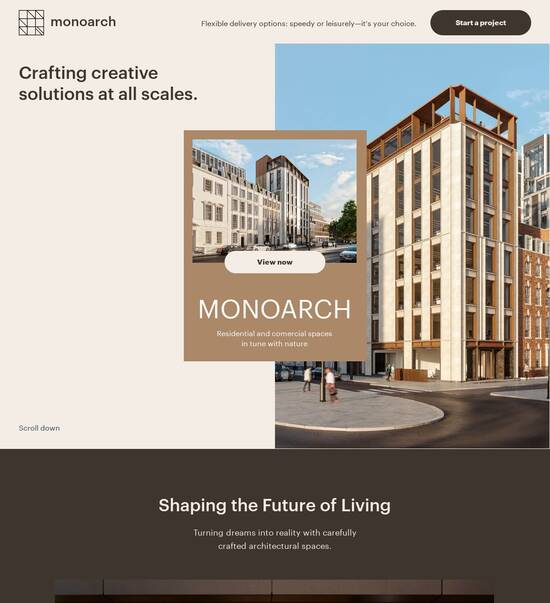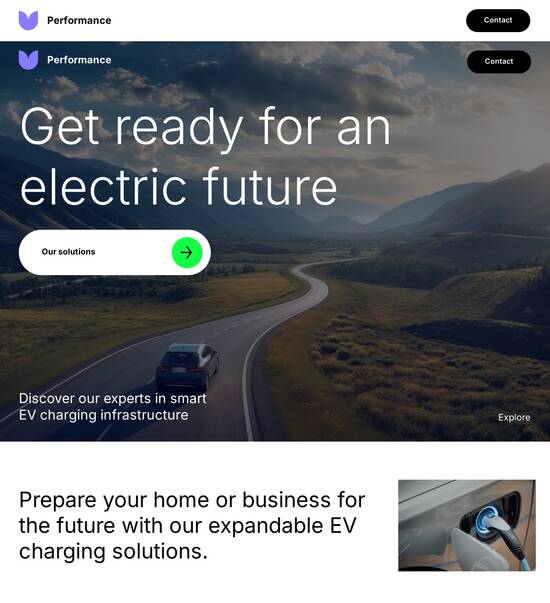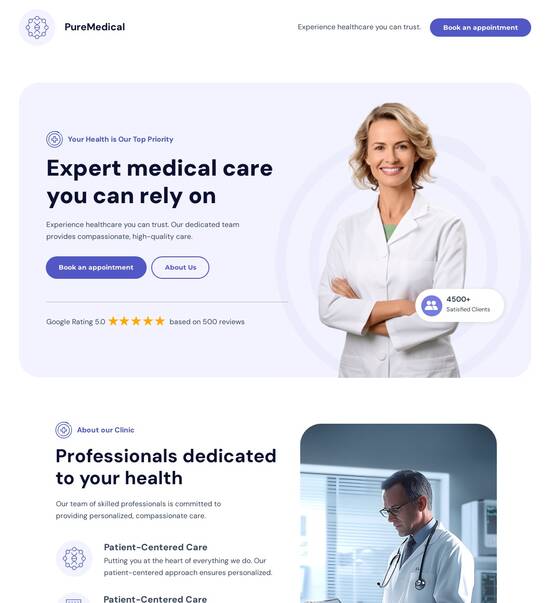
Attractive 401 unauthorized page template
Explore Similar TemplatesAbout template
Unleash your creativity with the attractive 401 unauthorized page template. Try Instapage today.
Recommended templates

Easy to build without coding
With the intuitive drag-and-drop builder, anyone on your team can create high-converting pages without any knowledge of code or design. Make enhancements to your landing page with custom widgets using Javascript, HTML/CSS, or third-party scripts.

Multiple layouts for any industry and goal
Select from 500+ landing page layouts built to boost conversions across industry-specific scenarios. Customize them by adjusting fonts, adding images, and generating on-brand content with the AI assistant. Quickly scale with Instablocks® and Global Blocks that you can save, reuse, and update globally.

Loads fast and looks polished on any device
Every template is responsive, which means they present professionally on any device and load blazingly fast with our Thor Render Engine. You can also power them up with Google AMP technology to deliver an unparalleled mobile experience and drive higher conversions.

Robust analytics & experimentation
Get real-time updates and reporting across all your devices, showing the number of visitors, conversions, cost-per-visitor, and cost-per-lead. Launch AI-powered experiments, run A/B tests, and use heatmaps to analyze user behavior, then optimize your landing page to maximize conversions.







Easy to build without coding
With the intuitive drag-and-drop builder, anyone on your team can create high-converting pages without any knowledge of code or design. Make enhancements to your landing page with custom widgets using Javascript, HTML/CSS, or third-party scripts.
Multiple layouts for any industry and goal
Select from 500+ landing page layouts built to boost conversions across industry-specific scenarios. Customize them by adjusting fonts, adding images, and generating on-brand content with the AI assistant. Quickly scale with Instablocks® and Global Blocks that you can save, reuse, and update globally.
Loads fast and looks polished on any device
Every template is responsive, which means they present professionally on any device and load blazingly fast with our Thor Render Engine.
Robust analytics & experimentation
Get real-time updates and reporting across all your devices, showing the number of visitors, conversions, cost-per-visitor, and cost-per-lead. Launch AI-powered experiments, run A/B tests, and use heatmaps to analyze user behavior, then optimize your landing page to maximize conversions.
All the features you need to build unauthorized page template
Explore more featuresLearn how to build unauthorized page design
Frequently asked questions about 401 unauthorized page template
Leading the way in building high-performing landing pages





Unauthorized page template html: Your ultimate how-to guide
Creating an Attractive 401 unauthorized page template is essential for maintaining user engagement and communication during errors. By utilizing Instapage's robust landing page and conversion rate optimization (CRO) tools, marketers can design customizable error pages that not only inform users of unauthorized access but also direct them towards further actions.
Understanding the Importance of a 401 Unauthorized Page
The 401 unauthorized error page serves as a crucial touchpoint between your brand and users who encounter access limitations. An effective template can mitigate frustration and guide users back to valuable website resources. Using Instapage’s dynamic text replacement, you can personalize these pages based on user data, maintaining a consistent brand voice.
- User Experience: A good 401 page enhances user experience by offering a friendly message instead of a generic error.
- Guided Actions: Include links to other relevant pages, ensuring that users have options to continue exploring your site.
- Branding Opportunity: Use this moment to reinforce your brand identity, keeping the message in line with your overall marketing efforts.
Step 1: Leveraging Instapage Templates
The first step in creating your Attractive 401 unauthorized page template is to leverage the high-converting templates available on Instapage. You can choose a layout that aligns with your brand’s aesthetics and customize it in mere minutes.
- Select a Template: Choose from 100+ pre-designed templates that cater to different business needs.
- Customize Visuals: Utilize Instapage's intuitive editor to change colors, fonts, and images for brand consistency.
- Preview & Optimize: Test different layouts and messages to see what resonates best with your audience.
Step 2: Implementing Optimization Features
After establishing your template, the next step is to implement optimization features. Instapage offers built-in experimentation tools for A/B testing, allowing you to determine which elements best engage your users.
- A/B Testing: Create variations of your 401 page to test different messages and layouts.
- Analytics Tracking: Leverage heatmaps to analyze user interactions and refine content accordingly.
- User Feedback: Incorporate user surveys on the page to gather insights directly from visitors.
Step 3: Monitoring Performance
Finally, consistently monitor the performance of your Attractive 401 unauthorized page template. The data collected will help you adjust the design and content to improve conversions and decrease bounce rates.
- Engagement Metrics: Track how users interact with your 401 page to identify potential improvements.
- Conversion Goals: Set clear objectives for user actions taken from the error page.
- Continuous Improvement: Regularly analyze performance data to adapt to changing user behaviors.
By following these steps, you can ensure that your 401 unauthorized page not only informs but also engages visitors effectively.
Ready to enhance your marketing strategy? Start with Instapage to create your Attractive 401 unauthorized page template and transform user experiences today!
Attractive 401 unauthorized page templates: Designing for user experience
Understanding the 401 unauthorized status code
The 401 Unauthorized status code is a crucial HTTP response indicating that a request has not been applied because it lacks valid authentication credentials. Understanding its significance is vital for web developers and marketers alike, as it not only pertains to user access but also impacts the overall security of a website. When a user encounters a 401 status, it signals that they need proper authorization to access the requested resource, underscoring the importance of user authentication and data protection in web applications.
In the context of web applications, encountering a 401 error typically suggests that a user may need to log in or authenticate their credentials. This can be particularly significant for websites dealing with sensitive data, ensuring that only authorized users have access to certain areas. A thoughtful approach to this error page can turn a potential obstacle into an opportunity for better engagement.
The 401 status code is a client-side error specifically related to authentication.
It is distinct from the 403 Forbidden, which indicates that the server is refusing action despite valid credentials.
Unlike a 404 Not Found error, which means the resource does not exist, a 401 is a request to authenticate.
The aesthetics of an attractive 401 unauthorized page template
Visual appeal plays a significant role in user engagement, particularly when users encounter errors while navigating a website. An attractive 401 Unauthorized page can not only provide information but can also retain users who might otherwise leave the site frustrated. Effective design elements, including an engaging color palette, readable typography, and relevant imagery, contribute to a better user experience. This aesthetic approach can assist in mitigating user frustration and encouraging the user to take the necessary next steps.
Moreover, incorporating emotional considerations into the design can further enhance user experience. A page that conveys empathy can help in building rapport with users. For example, using humorous graphics or playful messaging can serve as a gentle nudge that softens the blow of an error message, leading to a more consistent return to the site rather than abandonment.
Essential features of an effective 401 unauthorized page template
An effective 401 Unauthorized page template must deliver clear messaging while providing user guidance. A straightforward explanation of the error, specifying the reason behind it, can alleviate confusion. Additionally, offering suggestions for next steps, such as providing a link to log in or information on how to contact support, can help redirect users, minimizing potential frustration. Clear messaging helps set expectations and conveys transparency.
Interactive elements can also play a critical role in assisting users. Integrating a list of frequently asked questions (FAQs) related to authentication issues or enabling a community Q&A section fosters a sense of belonging and provides immediate help. Including a streamlined contact form or a live chat option can facilitate swift resolution of issues, giving users the feeling that their concerns are being addressed promptly.
Clear display of error message explaining the 401 error.
Links to login or authentication assistance.
Interactive FAQs to resolve common issues.
Options for contacting support directly.
Template design technologies
Designing responsive 401 Unauthorized page templates is crucial for accessibility across various devices. With the prevalence of mobile web usage, adopting a mobile-first design approach ensures that the page functions optimally regardless of the user's device. Utilizing frameworks like Bootstrap or CSS Grid can streamline the responsive design process, allowing for quicker and more efficient adjustments to layout and content that enhance user interaction on both desktop and mobile.
Leveraging modern web technologies, including HTML5, CSS3, and JavaScript, adds significant value to user experience. These tools can enhance visual engagement, animate responses, and make the error resolution process more intuitive. For instance, implementing JavaScript can enable dynamic content updates based on user input, thus enriching the interactive elements of the page. Popular content management systems (CMS) like WordPress, Drupal, and programming languages like Ruby on Rails can also be beneficial in creating and managing these customized pages.
Building a personalized user experience
Creating a personalized experience on a 401 Unauthorized page can significantly improve user retention and satisfaction. By utilizing user data to customize messaging, businesses can proactively address user needs. Techniques such as tracking user behavior and analyzing interaction patterns help inform how best to tailor content for specific audiences, oh-so-important in reducing bounce rates when errors occur.
Furthermore, implementing location-based enhancements can be a game changer. By utilizing geolocation APIs, businesses can offer tailored assistance based on the user's geographic location. This can include localized troubleshooting tips or connection to nearby support resources, ultimately making users feel more connected and supported in their experience.
Collect user behavior data for actionable insights.
Use geolocation to customize the error page experience.
Implement user feedback mechanisms to guide ongoing improvements.
Leveraging community knowledge and collective input
Engaging user communities provides valuable insights that can guide the development of an effective 401 Unauthorized page. Encouraging feedback from users helps identify areas for improvement and highlights common frustrations that input can address. Furthermore, by hosting community forums or feedback sessions, businesses can foster a sense of ownership, leading to a more refined and user-centered design process.
Collaborative design approaches enhance creativity and innovation. Utilizing tools like Figma or Sketch allows team members to brainstorm, share visions, and iterate on designs collectively. Best practices in gathering input include structured workshops or collaborative brainstorming sessions that encourage open dialogue, ensuring that multiple perspectives are considered in the design process.
Optimizing 401 unauthorized page templates for SEO
When constructing a 401 Unauthorized page, it’s important to consider technical SEO aspects. Properly formatting metadata and header tags helps convey the error type to search engines while also providing clear context to users. The way the 401 status code is handled in site maps can influence how search engines interpret and index the page, making clear navigation essential for optimal performance.
Enhancing discoverability through relevant content is another critical factor. Crafting informative content around common authorization issues allows for a supportive knowledge base that users can consult. Integrating this informative approach coupled with on-page SEO techniques effectively guides users toward solutions, ultimately improving their experience even when they encounter an error.
Previews and testing of 401 unauthorized templates
Iterative testing is essential to refine and enhance the effectiveness of 401 Unauthorized page templates. A/B testing can reveal which design elements perform best and how users interact with the various features of the template. Gathering user testing feedback allows for a targeted approach to identifying pain points, enabling developers to adapt and optimize the page based on genuine user experiences.
Mockups and interactive prototypes are instrumental in the design process, enabling teams to visualize the end product before it is finalized. Tools like InVision and Adobe XD can facilitate this process, offering a platform to create clickable mockups for real-time feedback. Implementing best practices for gathering feedback during the prototyping phase ensures that the final design resonates with users' needs and expectations.
Overcoming common pitfalls in 401 unauthorized page development
Technical misconfigurations can severely undermine the effectiveness of 401 Unauthorized page templates. Common issues might include misconfigured authorization servers, which lead to misleading messages for users. Clearly showcasing informative error messages and detailing how to rectify the issue can significantly mitigate user confusion and enhance their experience during a challenging moment.
Transparency is key in maintaining user trust. Communicating security protocols clearly helps users understand their rights and the importance of authentication. Striking a delicate balance between stringent security measures and user accessibility is essential; transparency regarding protocols demystifies processes and encourages users to feel comfortable engaging with your website despite encountering errors.
Future trends in 401 unauthorized page design
The landscape of web design is constantly evolving, particularly as emerging technologies influence user experience. AI and machine learning are revolutionizing how user data is utilized, predicting user behavior, and providing personalized experiences. As these technologies develop, they will likely lead to a more intuitive interaction, even when users encounter a 401 Unauthorized error.
Moreover, evolving standards and best practices demand an adaptive approach to web design. Shifting user expectations dictate a growing emphasis on seamless experiences, even in error scenarios. Anticipating changes in authorization protocols and web standards will be essential for maintaining user satisfaction and ensuring that error pages remain effective and user-friendly.
Ready to skyrocket conversions?
Supercharge your ad campaigns with high-performing landing pages
Get started














